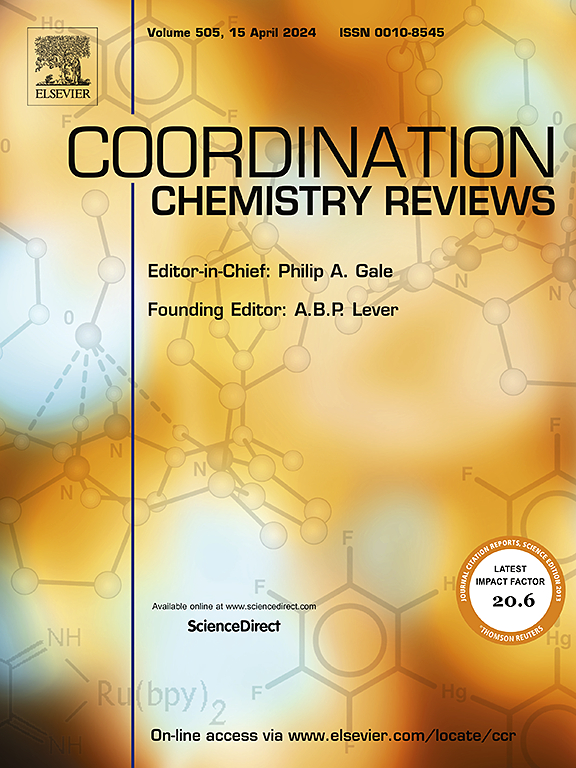Cu(I)螯合剂:揭示和控制Cu(I)稳态和毒性的有用工具
IF 20.3
1区 化学
Q1 CHEMISTRY, INORGANIC & NUCLEAR
引用次数: 0
摘要
铜(Cu)是许多生物过程中必需的微量元素,包括能量产生、有氧呼吸和抗氧化防御。尽管它很重要,但铜稳态的破坏可导致严重的病理状况,如威尔逊病(WD)、门克斯病(MD)、阿尔茨海默病(AD)和癌症。本文综述了Cu(I)探针和螯合剂作为理解和管理铜相关毒性和失调的分子工具的作用。综述了Cu(I)配位化学、转运途径和Cu的双重毒性机制(ros依赖性和非ros依赖性)。重点介绍了研究Cu(I)的关键实验方法,包括发色探针和荧光探针,重点介绍了它们的设计、应用和局限性。最后,讨论了Cu(I)靶向配体的治疗潜力,展示了它们在对抗氧化应激和恢复疾病中金属稳态中的作用。因此,本文综述了Cu(I)螯合作用在促进对铜相关疾病的基本认识和治疗策略方面的作用。本文章由计算机程序翻译,如有差异,请以英文原文为准。

Cu(I) chelators: Useful tools to reveal and control Cu(I) homeostasis and toxicity
Copper (Cu) is an essential trace element for numerous biological processes, including energy production, aerobic respiration, and antioxidant defense. Despite its importance, disruptions in Cu homeostasis can lead to severe pathological conditions, such as Wilson's disease (WD), Menkes disease (MD), Alzheimer's disease (AD), and cancer. The present review focuses on the role of Cu(I) probes and chelators as molecular tools for understanding and managing copper-related toxicity and misregulation. It provides an overview of Cu(I) coordination chemistry, trafficking pathways, and the dual toxicity mechanisms of Cu (both ROS-dependent and ROS-independent). Key experimental approaches to study Cu(I), including chromophoric and fluorescent probes, are highlighted, with a focus on their design, applications, and limitations. Finally, the therapeutic potential of Cu(I)-targeting ligands is discussed, showcasing their role in fighting oxidative stress and restoring metal homeostasis in diseases. Hence, this review offers a comprehensive perspective on Cu(I) chelation's role in advancing both fundamental understanding and therapeutic strategies against copper-related disorders.
求助全文
通过发布文献求助,成功后即可免费获取论文全文。
去求助
来源期刊

Coordination Chemistry Reviews
化学-无机化学与核化学
CiteScore
34.30
自引率
5.30%
发文量
457
审稿时长
54 days
期刊介绍:
Coordination Chemistry Reviews offers rapid publication of review articles on current and significant topics in coordination chemistry, encompassing organometallic, supramolecular, theoretical, and bioinorganic chemistry. It also covers catalysis, materials chemistry, and metal-organic frameworks from a coordination chemistry perspective. Reviews summarize recent developments or discuss specific techniques, welcoming contributions from both established and emerging researchers.
The journal releases special issues on timely subjects, including those featuring contributions from specific regions or conferences. Occasional full-length book articles are also featured. Additionally, special volumes cover annual reviews of main group chemistry, transition metal group chemistry, and organometallic chemistry. These comprehensive reviews are vital resources for those engaged in coordination chemistry, further establishing Coordination Chemistry Reviews as a hub for insightful surveys in inorganic and physical inorganic chemistry.
 求助内容:
求助内容: 应助结果提醒方式:
应助结果提醒方式:


